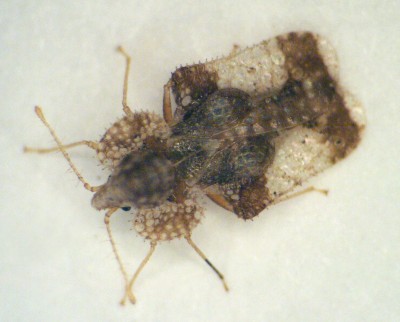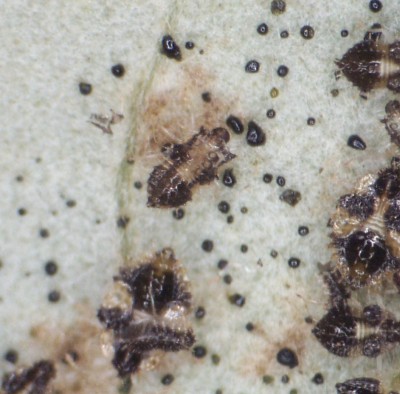Lace Bugs
 Scientific Name
Scientific Name
Corythucha spp.
Hosts
Most lace bugs have very specific host preferences. The sycamore lace bug feeds on sycamore, the elm lace bug on American elm, the oak lace bug on oaks, and the hawthorn lace bug on pyracantha, hawthorn, and quince. Other Oklahoma species of Corythucha feed on buckeye, black cherry, black walnut, hickory, alder and birch. One species feeds on sunflowers and related plants.
Distribution
Various species of Corythucha can be found over the entire U.S. and in all parts of Oklahoma where their host plants are present.
Damage
Feeding causes yellow or white (chlorotic) spots to appear on the upper surface of the leaf. These are similar to leafhopper and spider mite damage but usually more extensive. Positive identification of lace bug damage is confirmed by the presence of shiny, black droplets of excrement on the underside of damaged leaves. Frequently, the cast skins of the nymphs remain attached to the underside of the leaves.
Life Cycle
 Lace bugs overwinter as adults in bark crevices, branch crotches, or similar protected
areas of their host plants. They emerge about the time leaves of the host develop
in the spring. Small black eggs are attached to the underside of leaves with a sticky
brown substance. Within a few days, the eggs hatch and nymphs begin feeding on the
leaves. With their sucking mouthparts they pierce the leaf and withdraw fluids and
cell contents. A complete life cycle, from egg to adult, may be completed in approximately
30 days. Several generations occur each year in Oklahoma.
Lace bugs overwinter as adults in bark crevices, branch crotches, or similar protected
areas of their host plants. They emerge about the time leaves of the host develop
in the spring. Small black eggs are attached to the underside of leaves with a sticky
brown substance. Within a few days, the eggs hatch and nymphs begin feeding on the
leaves. With their sucking mouthparts they pierce the leaf and withdraw fluids and
cell contents. A complete life cycle, from egg to adult, may be completed in approximately
30 days. Several generations occur each year in Oklahoma.
Description
Adult lace bugs have beautifully sculptured wings that resemble an intricate, lacy network. There are also lacy extensions at each side on the front part of the body and an expanded, lacy hood that extends over the head. Some species are almost entirely white while others are marked with black or brown. They range in size from 1/8 to 3/16 inch. Nymphs do not have wings but usually have spines on the back.
Common Oklahoma species include the following: sycamore lace bug, C. ciliata (Say) - white with a small brown spot on each wing; oak lace bug, C. arcuata (Say) - with an ill-defined, dark crossbar near the end of the wings and other markings that are dark brown; elm lace bug, C. ulmi Osborn & Drake - without an apical crossbar on the wings and other markings pale brown; and hawthorn lace bug, C. cydoniae (Fitch) - with a larger-than-normal hood and extensive dark brown markings.
Control
Natural enemies, including lacewing larvae, assassin bugs, spiders, and predaceous mites, sometimes keep lace bug infestations under control. Heavy infestations may, however, need to be treated. Lace bugs are not particularly difficult to control with most readily available ornamental insecticides, but thorough coverage is critical. Please contact your local county extension office for current information.
